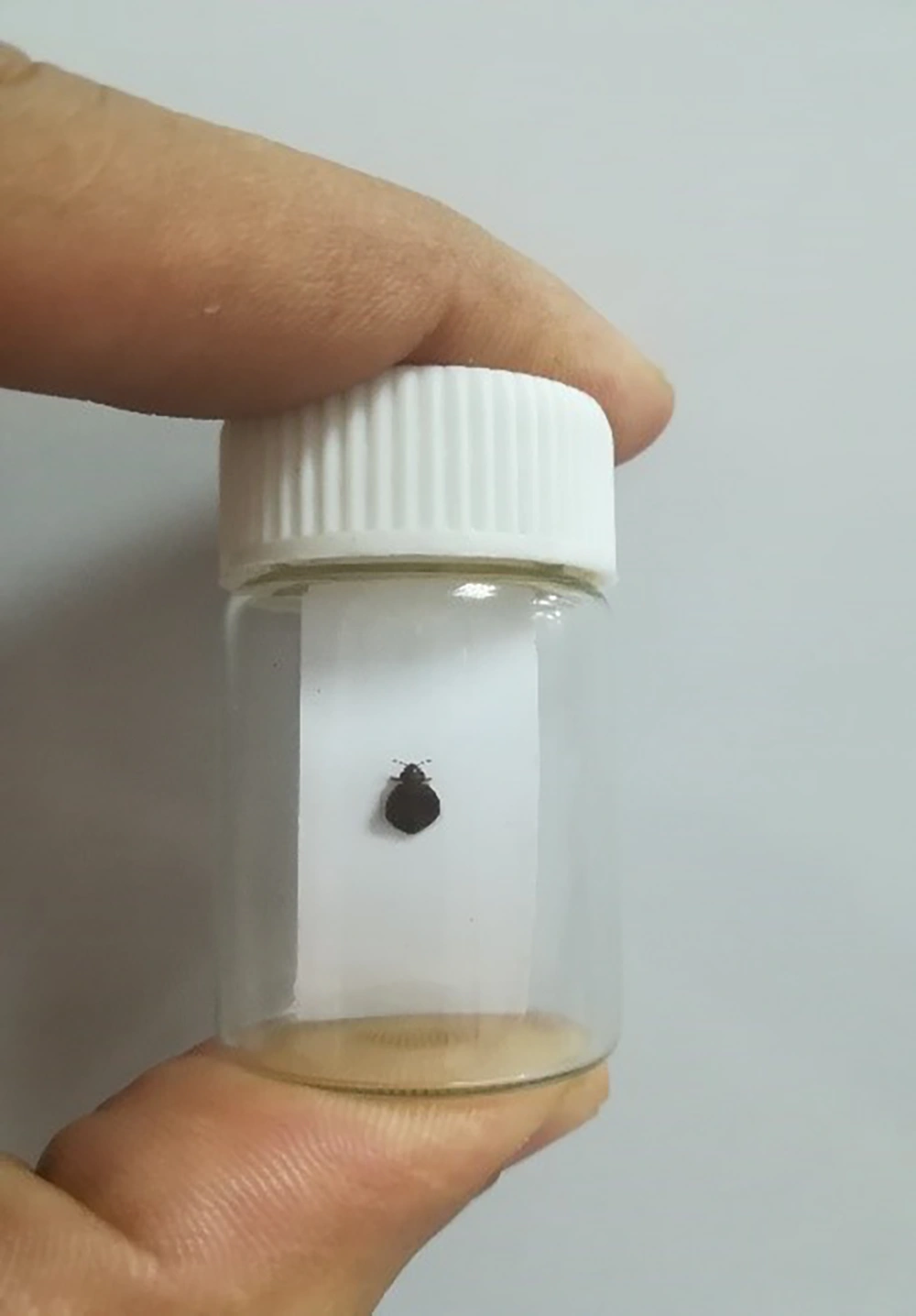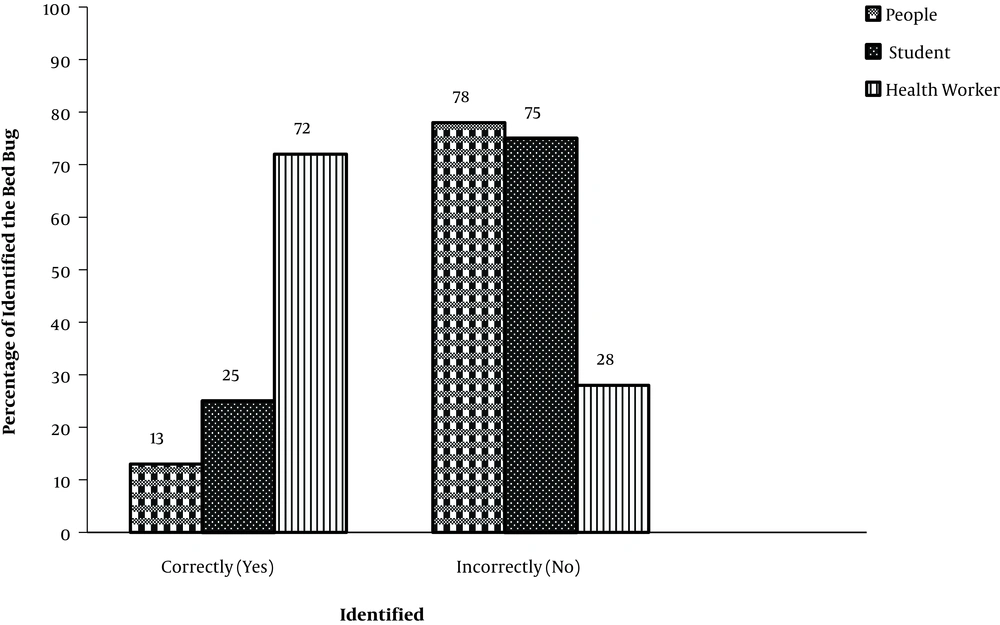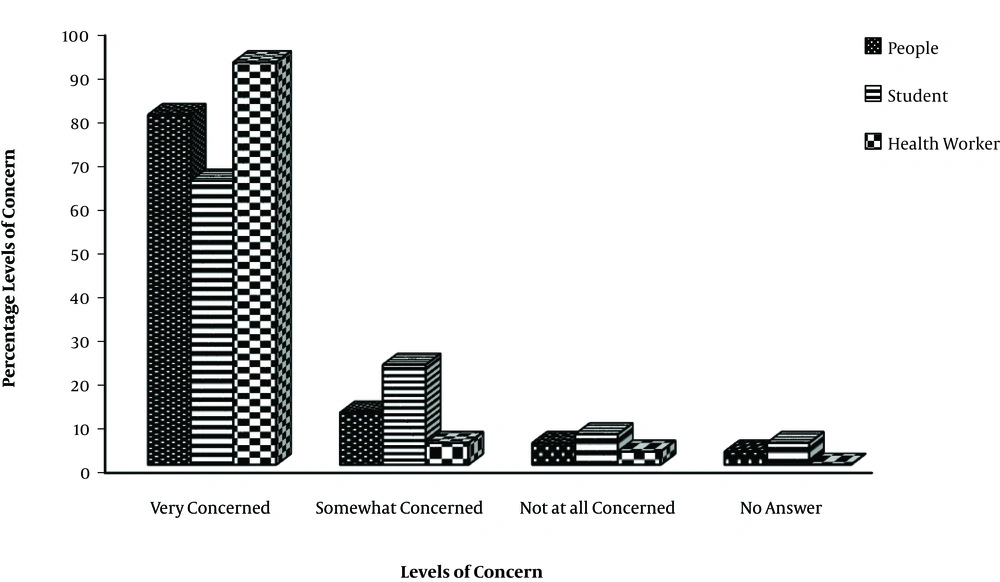1. Background
The common bed bug (Cimex lectularius L.) is an urban pest and obligate bloodsucking insect that feeds on humans (1). This public health nuisance insect is known as the most difficult infestation with no pesticides readily available to reduce the bed bugs (2). Bed bug infestation is a neglected and unreported health and medical concern despite of the other vector borne diseases such as leishmaniosis, malaria and Crimean-Congo hemorrhagic fever, which is increasing in the countries worldwide. There is scant information about the increasing bed bug infestation, but it maybe due to increased levels of international transport through tourism and trade, immigration and insecticide resistance can be the reason for this increase and the prevalence of this urban pest (3). Cimex spp. are the minor threat to human health and there are few researches on bed bug infestation in Iran. The prevalence of bed bug is reported in the range of 6.7% to 90.7% in Kohgiloyeh-and-Boyerahmad, Mazandaran, Khorasan Razavi, and Isfahan provinces (4-7). A cross sectional study was conducted in rural areas of Bahnamir city in Mazandaran Province that about 33.2% and 66.8% of collected bed bugs from bedrooms were nymph and adult, respectively (6). The insect niches contain vast environments such as cracks of bed, curtains, floorboards, wallpaper, upholstery, picture frames, electrical switch plates, mattresses, carpets, back of paintings, and skirting (8). Their infestation can cause psychological distress with nightmares, insomnia, anxiety, avoidance behaviors, and personal dysfunction. In addition, bed bug bites are associated with infestations of private and public places that cause the psychological effects in some individuals (9, 10). An allergic reaction with cutaneous itching as a common sign was observed in the forearm of a 28-year-old male who was resident of Ahvaz city after bed bug bite (11).
The bed bug is a severe public health issue with difficult and costly eradication method; they are ordinarily cryptic and thus hard to find, particularly in low density infestation (12). The knowledge about the morphology, biology, smell, and understanding the behavior of bed bugs are noted as critical points in the detection of primary infestations and bed bug resurgence (13).
One of the most important factors to increase the bed bug infestation is a general lack of public knowledge about this insect. Furthermore, an important factor to increase the bed bug population is due to the risk of their distribution by second-hand devices in low-income countries that contain bed bug (14).
2. Objectives
The current study reported the response of Ahvaz residents in three categories regarding identifying bed bug specimens in glass and figure and evaluating their awareness by the questionnaire. Besides, it provided the opportunity for health authorities to recognize, manage and control this public health concern timely before the resurgence happen.
3. Methods
3.1. Study Design and Population
A descriptive cross-sectional study was conducted from June to July 2016 in Ahvaz city, Southwest of Iran. Three groups of residents, including health workers, medical and pharmacy students, and the ordinary people participated in the current study randomly. A total of 180 individuals (60 subjects in each group) took part in the present survey.
3.2. Data Collection
A 10-item researcher-made questionnaire was completed by the participants. Five questions assessed the level of knowledge and awareness in participants about bed bug habitat, transmission, medical importance, prevention, and control methods. Also, other questions provided data about the gender, age, level of education, and residence. For better understanding, besides a picture of the insect, a dead bed bug in the vial was shown to the participants (Figure 1). It was refused to use a live form of insects to prevent anxiety and fear in participant.
3.3. Statistical Analysis
Collected data were analyzed with SPSS version 16. Descriptive analysis was conducted and the results were expressed as mean ± standard deviation (SD) to show the knowledge level of people about bed bug infestation based on gender, level of education, and age. The Chi-square test was used to compare different groups. Otherwise, graphs were drown by Microsoft Excel 2013.
4. Results
4.1. Demographics
A total of 180 residents of Ahvaz city were interviewed. Of the 60 individuals surveyed in the residents group, 3% (n = 5) were illiterate, 44% (n = 25) below high school diploma, 23% (n = 13) had high school diploma, and 30% (n = 17) had academic degree (Table 1). The majority of respondents were in the age range of 20 to 29 years (Table 1). In the current research, most of the participants among university students and health workers were male.
| Characteristics | Resident | University Student | Health Worker |
|---|---|---|---|
| Gender | |||
| Female | 30 (50) | 23 (38) | 28 (47) |
| Male | 30 (50) | 37 (62) | 32 (53) |
| Age, y | |||
| 20 - 29 | 21 (35) | 60 (100) | 23 (36) |
| 30 - 39 | 17 (28) | 0 (0) | 2 (38) |
| 40 - 49 | 16 (27) | 0 (0) | 11 (17) |
| 50 and over | 6 (10) | 0 (0) | 2 (9) |
| Education | |||
| College education | 17 (30) | 60 (100) | 60 (100) |
| High school | 13 (23) | 0 (0) | 0 (0) |
| Below high school diploma | 25 (44) | 0 (0) | 0 (0) |
| Illiterate | 5 (3) | 0 (0) | 0 (0) |
| Accommodation | |||
| New villa | 13 (22) | 7 (11) | 4 (7) |
| Old villa | 6 (10) | 3 (5) | 8 (13) |
| New apartment | 13 (22) | 4 (7) | 19 (32) |
| Old apartment | 28 (46) | 6 (10) | 29 (48) |
| Dormitory | 0 (0) | 40 (67) | 0 (0) |
The Demographic Characteristics of the Study Participantsa
The mean age of the residents group was 40.03 ± 14.113 of which 50% were male and 50% female, and the mean age of the university students group was 24.31 ± 2.72 of which 62% were male and 38% female; also, the mean age of the health worker group was 35.8 ± 7.15 of which 53% were male and 47% female.
Except the student group, most people in the other two groups lived in old-fashioned buildings (apartments and villas). The results of the current study showed that most of the subjects in the residents group lived in old apartments (46%), and in the university students group was dormitory (67%), and in the health workers group was old apartments (48%). The demographic characteristics of Ahvaz residents from three groups are described in Table 1.
4.2. Identify of the Respondents Towards Bed Bug
Seventy-two health workers could identify a bed bug correctly. Only 25% of students of the university had enough knowledge to recognize the bed bug morphology. Furthermore, correct identification among the third group was 13% (Figure 2).
There was no significant correlation between the ability to correctly identify a bed bug and age (χ2 = 0.012; df = 3; P = 0.403). And there was no association between the knowledge of respondent toward bed bug and age (χ2 = 0.041; df = 3; P = 0.059).
Hence, it can be assumed that participants with higher education could better identify the insect but no significant result was observed (χ2 = 0.017; df = 3; P = 0.056). Moreover, there was no relationship between the knowledge of residents group and their education (χ2 = 0.002; df = 3; P = 0.32).
The level education in the residents group was 30% educated, 23% high school diploma, 44% below high school, and 3% illiterate; there was a significant correlation between the level of concern and the level of education (χ2 = 0.041; df = 9; P = 0.041).
4.3. Knowledge and Awareness of the Respondents Towards Bed Bug
The knowledge of the participants was evaluated regarding five variables including transmission, medical importance, habitat, prevention and control of bed bug (Table 2).
| Variable | Residents | University Students | Health Care Worker |
|---|---|---|---|
| Transmission of bed bug | |||
| Contact with infected person | 4 (6.66) | 12 (20) | 2 (3.33) |
| By infected equipment | 21 (35) | 12 (20) | 3 (5) |
| Travelling to an endemic area | 13 (21.66) | 4 (6.66) | 1 (1.66) |
| All items | 22 (36.66) | 32 (53.33) | 54 (90) |
| Medical importance of bed bug | |||
| Blood feeding and itching | 25 (41.66) | 30 (50) | 45 (75) |
| Blood feeding and disease transmission | 27 (45) | 12 (20) | 13 (21.66) |
| No blood feeding, but disease transmit | 8 (13.33) | 18 (30) | 2 (3.33) |
| Bed bug habitat | |||
| Kitchen | 4 (6.66) | 5 (8.33) | 1 (1.66) |
| Cracks and crevices | 23 (38.33) | 45 (75) | 30 (50) |
| Toilets | 12 (20) | 2 (3.33) | 13 (21.66) |
| All items | 21 (35) | 8 (13.33) | 16 (26.66) |
| Control of bed bug infestation | |||
| No need to control | 4 (6.66) | 1 (1.66) | 2 (3.33) |
| Sanitation, washing, vacuuming, steaming, and spraying | 10 (16.66) | 19 (31.66) | 55 (91.66) |
| Do not buy second-hand instruments | 1 (1.66) | 2 (3.33) | 1 (1.66) |
| All items | 45 (75) | 38 (63.33) | 2 (3.33) |
| Prevention of bed bug infestation | |||
| Checking bed | 3 (5) | 6 (10) | 1 (1.66) |
| Public and personal hygiene | 15 (25) | 18 (30) | 2 (3.33) |
| Do not buy second-hand instruments | 2 (3.33) | 3 (5) | 1 (1.66) |
| All items | 40 (66.66) | 33 (55) | 56 (93.33) |
The Knowledge and Awareness Rate of the Study Respondents About Bed Bug in Ahvaz, Southwest of Iran, 2016a
Infected equipment and travelling to endemic areas were selected by 35% and 21.66% of the residents group, respectively, while about 53.33% of university students and 90% of the health worker believed that contact with the infected person, in addition to the two abovementioned items, causes infection. The majority of respondents recognized blood feeding and itching as medical importance of bed bug. Cracks and crevices were introduced as bed bug habitat by 38.33% of ordinary people, 75% of medical and pharmacy students, and 50% of health workers. About 91.66% of health workers reported sanitation, washing, vacuuming, steaming, and spraying as the methods to control bed bugs. The prevention methods of bed bug in 66.66% of residents, 55% of students, and 93.33% of the third group were checking the bed, public and personal hygiene, and refusing to buy second-hand instruments.
3.4. Level of Concern of the Respondents Towards Bed Bug
The level of concern of Ahvaz citizens in the three studied groups about bed bug was measured and shown in Figure 3. Moreover, 80% of residents, 65% of medical and pharmacy students, and 92% of health workers were very concerned about bed bug infestation. The remaining participants stated that they were not concerned, somewhat concerned, or had no idea about bed bug infection.
No significant correlation was observed between the concern level of respondents and their gender (χ2 = 0.986; df = 9; P = 0.986). Although most participants were in the age range of 20 to 39 years, no significant correlation was observed between the concern level of respondents and age (χ2 = 0.566; df = 9; P=0.566).
5. Discussion
The current study revealed better knowledge and awareness about bed bug of health workers than other groups of participants in Ahvaz. It may be attributed to the experience of health workers in the field of medical entomology.
Poor knowledge was reported in the residents group in the current study. In Great Britain, only 10.34% of respondents identified bed bugs correctly and elderly people had good knowledge about this urban pest that it was due to their experience in travelling to areas with high infestation and exposure to bed bug picture in the media (13). The current study results showed that the young people recognized bed bugs better than old ones. It may be explained by selection of the study groups since only eight individuals were 50 years or above and others were in the age range of 20 to 49 years.
The participant’s ability to identify a bed bug was about 34% in New Albania (2), about 12.5% in Germany (15), and only 30% in Hawaii (14), while the current study showed that about 25% of university students and 15% of ordinary people could recognize the adult bed bug correctly. Due to the poor knowledge of two study groups, the educational programs are critically needed.
Reinhardt et al. (13) revealed that respondents with higher education could better recognize bed bugs than the ones with lower levels of education. In the current study, the majority of participants were educated, but only 72% of health workers could correctly identify this pest. The experience of health workers was a success in recognizing the pest.
The poor recognition rate of participants may be due to the manner of presenting the pest. Seidel and Reinhardt introduced three effective factors to increase the recognition rate of bed bugs: previous contact with the insect, increase of knowledge through other people, and educational courses (15). About 73.1% of respondents indicated that they received bed bug information from their relatives or parents, while 36.9% of knowledge was gained via previous contacts or experience, health facility, and media/educational programs (16). The current study results also reported that the previous contact can have a long-lasting effect on identifying a bed bug that is in accordance to the conducted studies by Seidel and Reinhardt in Germany (15).
Wang et al. (17) demonstrated that non-chemical treatment reduced bed bug population promptly in low level infestation of the insect. Chemical methods are not completely effective in a field situation due to low-income housing environments (18). But the number of bed bugs reduced by using the integrated methods (mixture of spraying and non-chemical tactics) after two months the in infested areas (19). Remero et al. (20) demonstrated that integrated pest management (IPM) programs can cause significant reduction in bed bug populations in comparison with using insecticide approaches. Several methods are documented as guidelines for reduction of the bed bug incidence, including vacuuming all cracks and crevices, floor and furniture, washing washable things with water over 49°C and putting the plastic bags outdoors behind the sunlight (21). The current study also found that 55 of 60 health workers (91.66%) reported commitment to personal hygiene, washing, vacuuming, steaming, and spraying as combination methods for effective control of bed bugs. Moreover, this group can make residents more aware of the situation.
A classic habitat of bed bug includes cracks and crevices of walls and other materials (8). The current study results reported that most respondents in the studied groups introduced the cracks and crevices as the main bed bug habitats. Although students had poor bed bug recognition, they may guess its niche regarding insect size.
Cimex spp. are well known blood feeding pests and here is no studies have not been health problem but there are no published studies on the transmission of the disease to human by this insect (22). The majority of health workers (75%) had enough knowledge and awareness about medical importance of bed bugs.
According to the results of the current study, 35% of ordinary people believed that bed bugs were transmitted by the infected instrument. The most popular way of bed bug distribution is using second hand furniture, especially in multi-unit buildings such as apartments infected to bed bugs in low-income countries (14).
Bed bugs have great potential to disperse into many places after introducing a place (usually a room to hallway in an apartment) (23).
The level of concern was the critical question to help determine the awareness level of the public toward bed bug infestation and resurgence (14). The current study presented the relationship between education and the level of concern but in the comparison between the two educated groups, the health care workers were more concerned about bed bug infestation. The high level of health care workers’ concern may be due to their experience about making nuisance by the insect. About 90% of the public health officials believed that bed bugs were a public health concern (2).
It is recommended that further studies be conducted to evaluate the identification rate of public based on the other forms of a bed bug life cycle such as eggs, and nymphal stages. It can show the level of educational workshops needed for pest control training course. Encouraging behavior to teach people may create easier recognition, eradication, and prevention of this pest.
5.1. Conclusion
The early recognition of bed bugs before observing the typical signs such as many bugs, fecal stains, and cutaneous allergic reaction can help to prevent the insect resurgence and population growth.



